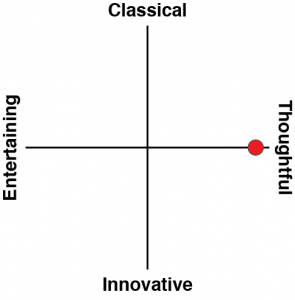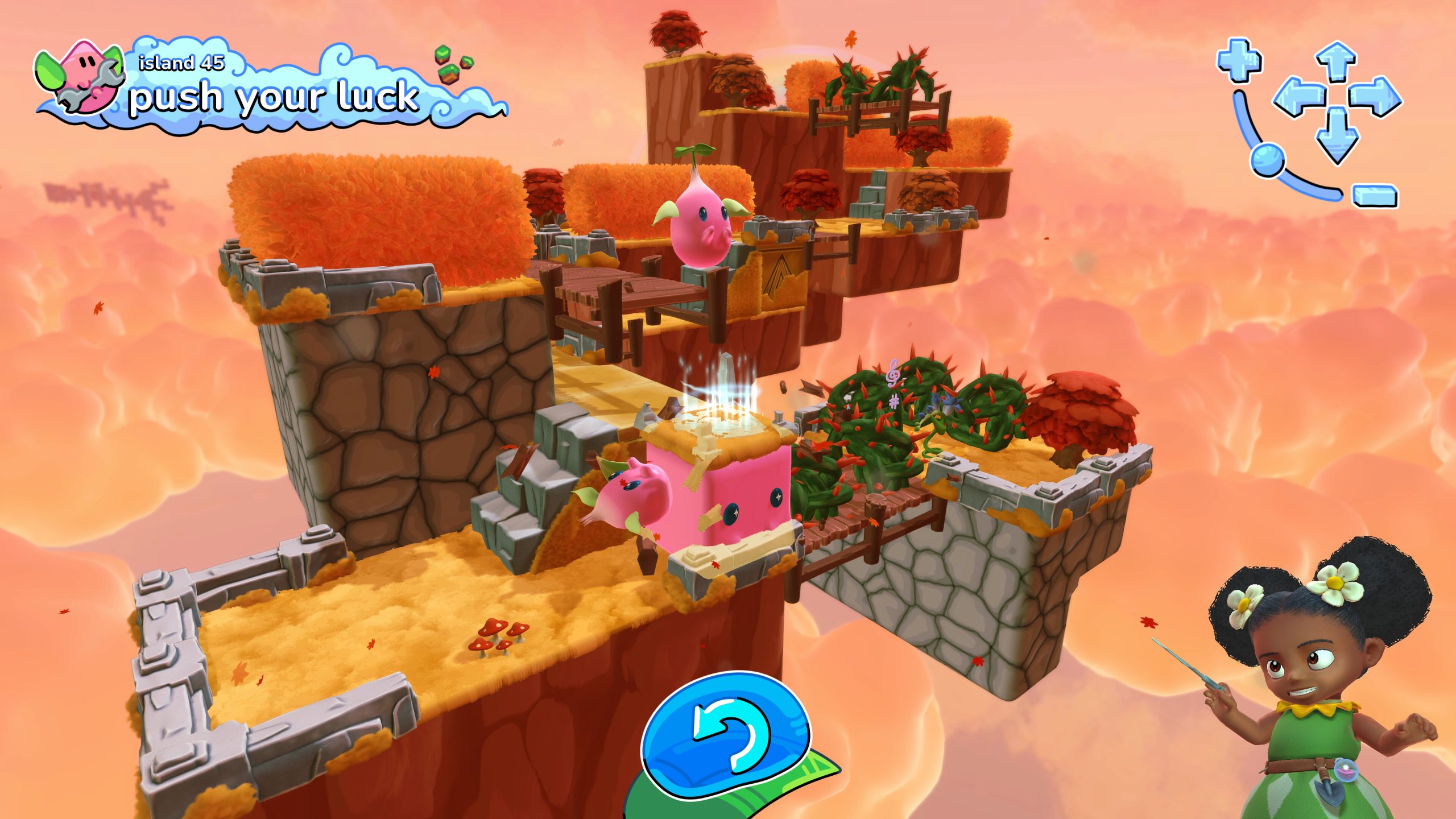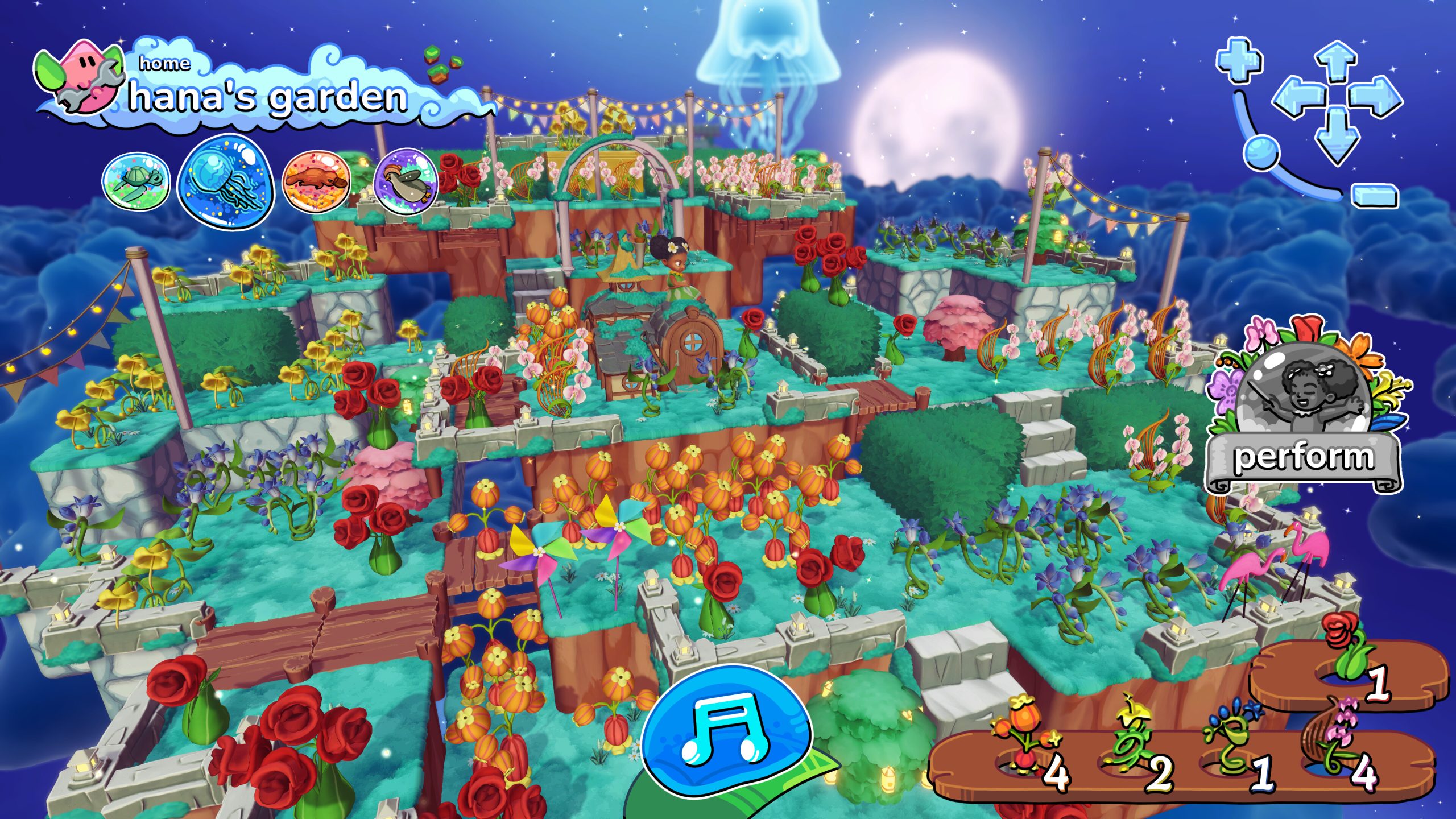In a world that is as toxic, complex, and fundamentally unpleasant as the one we now live, whimsical, wholesome little things like Tempopo are the escapism we need. It’s a simple puzzle game in many ways, but the sweet, buoyant presentation, and the brilliant way it integrates music into the experience elevate it to something every bit as memorable as the previous game to carry the Witch Beam label (the universally celebrated Unpacking).
Tempopo is an entirely different project to Unpacking. That one was, at its core, a storytelling experience. Tempopo is more ambient. There’s a set-up, when a young musical conductor girl accidentally blows away all the flowers on her island thanks to a horrible conducting performance. She then recruits the help of the Tempopo (pink blobby things) to collect the flowers that are now scattered across the islands in the sky. Yes, it’s a very abstract contrivance to set up a series of puzzle levels to play through. No, it doesn’t matter that it’s not overly coherent and there’s not much more to it than that. What does matter is that it establishes the abundance of charm that the rest of the game then trades on.
Once you get through the brief little cut scene that sets things up, you’re thrown into the 60 or so levels that make up the Tempopo experience. These levels look like Captain Toad: Treasure Tracker levels. In practice, they behave more like beloved classic Chu Chu Rocket. You have a simple objective: Have the Tempopo collect the flowers scattered around the level by moving over them, and then get them to an exit. You can’t directly control the Tempopo, however. They move directly forward of their own accord, regardless of whether that will take them into a trap or result in them leaping off the level. To stop them from self-destructing, you need to place down direction tiles in their path.
At the start of a level, the Tempopo are in a specific position and the action is paused. You need to put these tiles down, and then hit the “play” button to set the Tempopo in motion. These tiles range from the very simple (an arrow that will cause the Tempopo to change its direction) to the relatively complex. For example, one will turn the Tempopo into a block that can help others cross a gap. Another will cause the Tempopo to create a wind gust that can allow the other Tempopo to “jump”. Each level has a single solution, so the challenge is in figuring out the specific sports where to place the directions in the level. As you might expect, the levels do start out very easy and straightforward, but the difficulty does lift over time.
Tempopo never becomes frustrating, however. You’re free to restart a level as many times as you like, so even on the ones that are truly stumping you, a bit of trial and error can help you start to piece your way through it. Each level is very short, so you’ll never be stuck on one for long enough to become frustrated, and once you’ve placed all your tiles down and hit the “play” button, the music kicks in, and that’s a delight in its own right.
The Tempopo move to the beat of some bouncy, very creative music, one “square” in the play field per beat. Some of the puzzles require that you lay tiles around to make sure that the Tempopo are undertaking specific actions at the right beat of music. It’s by no means a rhythm game, but that tight interaction between music and the puzzle action gives the game an endearing energy, and adds another layer of creativity to the design.
There’s even an excellent bonus mode, which is whimsical and creative in its own right. As you collect these flowers in each level, you can take them back to the “garden”, and then place them around the environment however you like. That garden environment is a rough circle, and a metronome symbol continuously rotates around the environment. By placing the flowers in specific spots to match “timing” it’s possible to get these flowers to play a lovely little symphony. There are no objectives in this garden mode – it’s a pure sandbox to play around in – but it does show how important music is the Tempopo experience, and highlights the whimsical creativity behind the game down to its core.
It’s so close to perfect that the imperfections are minor irritations at most. The Captain Toad-like presentation doesn’t always work in Tempopo’s benefit, and you’ll realise pretty quickly why the simple, top-down, 2D presentation of Chu Chu Rocket was essential for this kind of game. You need to be able to see, and visualise, movement across the level without needing to zoom and pan the camera, and even then, Tempopo’s camera never seems to give you the perfect view of what you’re trying to look at.
The game also runs out of tricks too early. One of the great qualities of Nintendo’s own games is that the developers find new ways to surprise and delight you from the start, right through to the end. By the time you’re about halfway through Tempopo, you’ve seen the basics of just about all its tricks. From there, you’re just working on variations of those puzzles, and while they definitely become more challenging, a game this colourful and vibrant also needs to continue to surprise and delight players with new ways to play too.
But I’m being overly critical just for the sake of doing my job as a critic there. The fact is that as a fan of Chu Chu Rocket, I am continually disappointed that there isn’t more done with that kind of puzzler, and Tempopo more than scratched the itch. This has been my favourite puzzle game in years.














